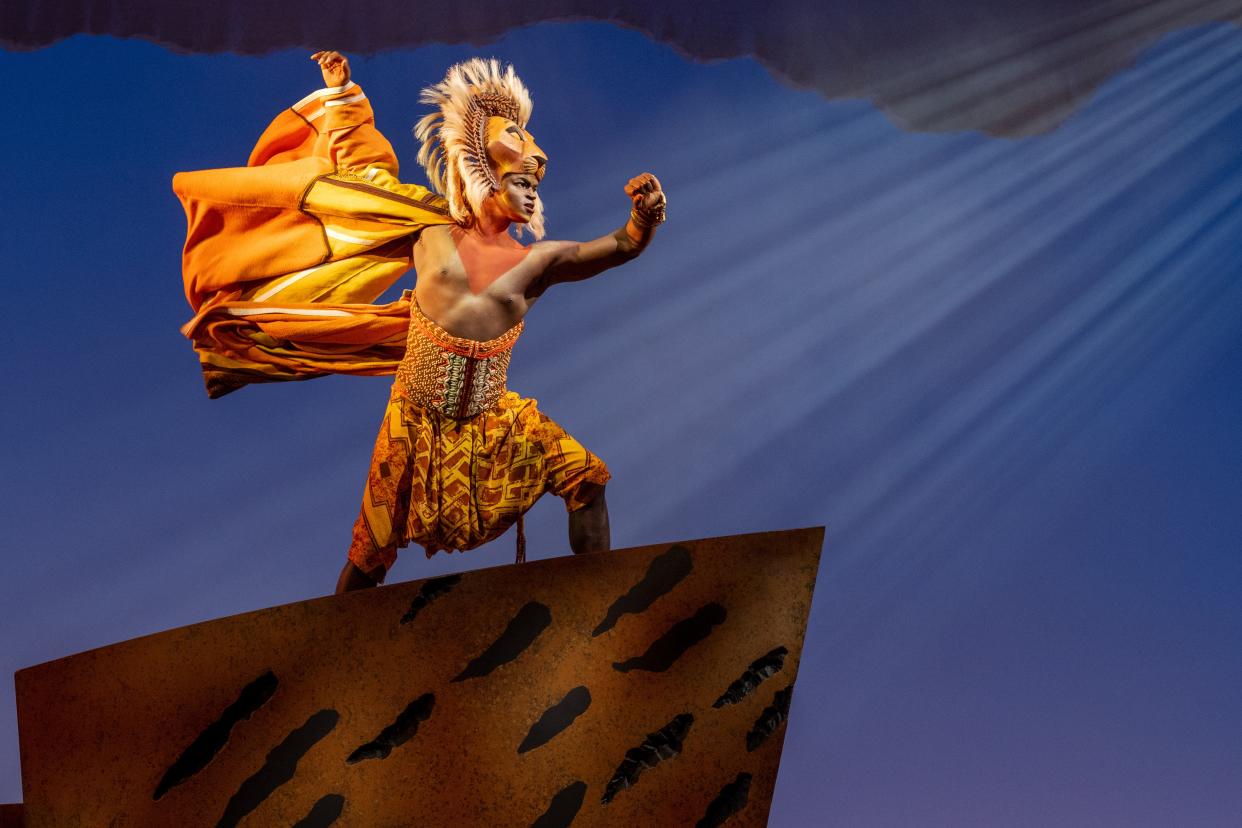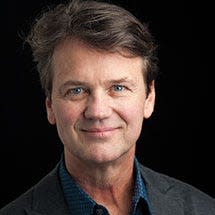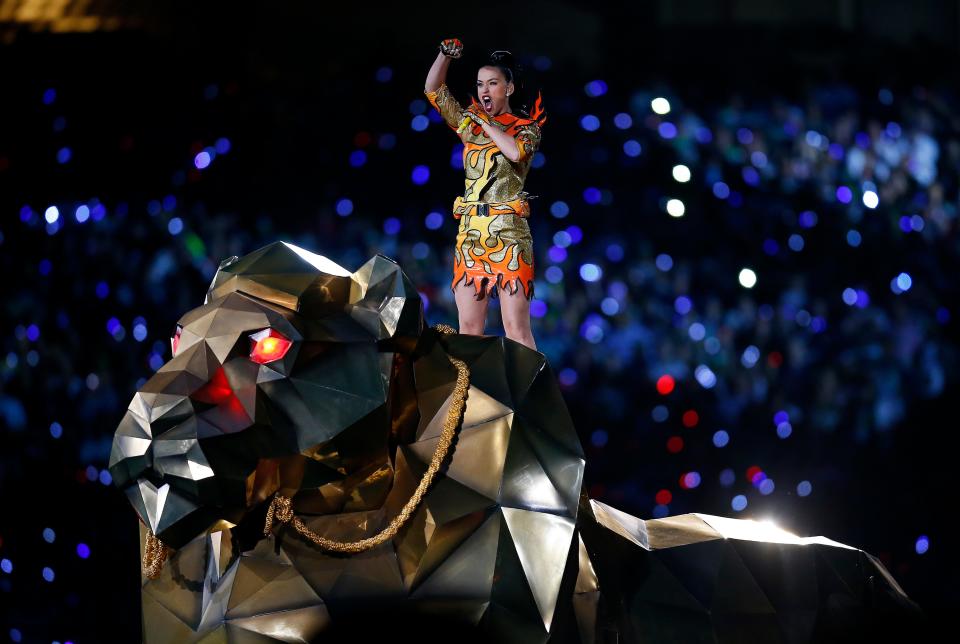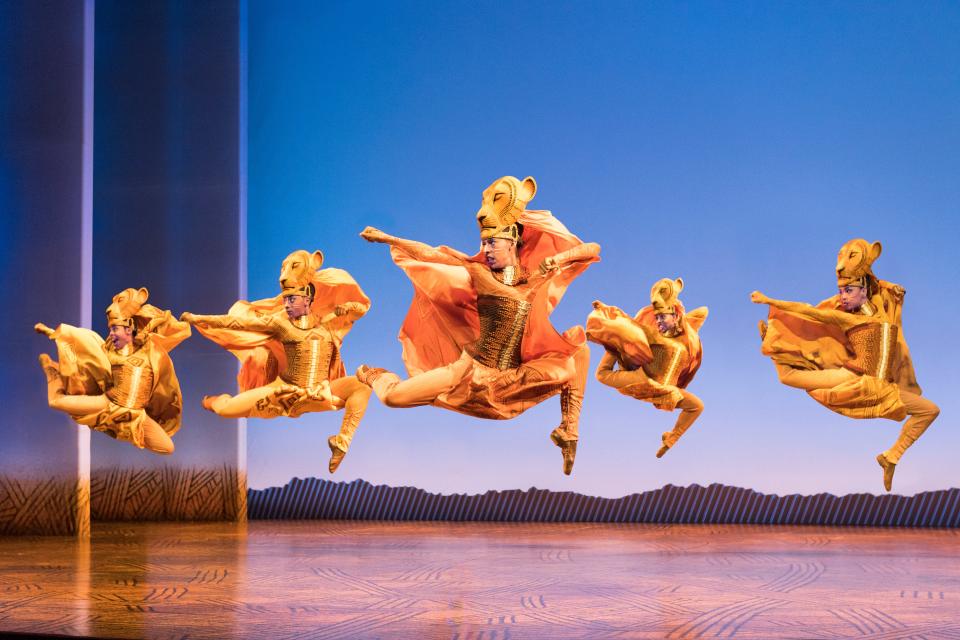The Kingmaker: Designer behind Lion King's costumes, puppets shares insights as Lubbock run wraps up

- Oops!Something went wrong.Please try again later.
Along with its iconic songs and story, The Lion King musical — just like the 1994 Disney film that inspired it — wouldn't be complete without the gazelles, zebras, hyenas, birds — and lions — that tell the tale.
As Disney's "The Lion King 2023" continues its multi-day run through Sunday at Lubbock's Buddy Holly Hall, a lead designer responsible for the visually stunning costumes and puppets audiences across the country have seen over the past three decades shared behind-the-scenes details about how they're created and continue to evolve.

Michael Curry, president of Michael Curry Design, Inc., serves as mask and puppet co-designer for The Lion King. It's a role he's continued since his Oregon-based studio helped design puppets and costumes for the Lion King musical that launched on Broadway in 1997.
For the show's run in Lubbock, Curry shared with the Avalanche-Journal insight about his process for creating all of the masks and puppets used in the show, as well as his work with high-profile performers and shows over the decades. Disney's "The Lion King 2023" will continue its run at Lubbock's Buddy Holly Hall through Sunday. And tickets are still available through buddyhollyhall.com.
Michael Curry's designs on small stages, the Super Bowl and beyond
Over 25 years, Michael has worked widely as a visual and concept designer for numerous companies, such as Disney Theme Parks and Theatrical Productions, Cirque du Soleil, The Metropolitan Opera, seven Olympics Opening and Closing Ceremonies, Universal Studios Theme Parks and many others. He collaborates regularly with visionary directors and producers.
Curry has received numerous prestigious awards, including several for his work on Broadway, Olympic ceremonies, and his continued innovations in the fields of scenic visual effects, and puppetry design. In the music industry, Curry is known for his innovative designs for such high-profile performers as Taylor Swift, Michael Jackson, Katy Perry, Lady Gaga and others. Many would recognize Curry's work with Perry for her appearance in the Super Bowl halftime show in 2015, which saw her ride into the stadium on a giant golden mechanical lion that Curry designed for her song "Roar."
Michael Curry Design, Inc. is comprised of 50 innovative designers and fabricators who conceive and produce state-of-the-art creations for live entertainment. His studio is located in Portland, Oregon.
Curry said his company's work with The Lion King began in the 1990s, before the show launched on Broadway. He said his company has remained active with the show over the years, including through its traveling musical performances.
Here's more of what Curry shared with the A-J. This interview has been edited for length and clarity.

A-J: How have your experiences been working with pop stars like Katy Perry at big venues such as the Super Bowl?
Curry: "For me, I'm really interested in a broad range of audiences … I really dig different forms of presentation. And pop music is something we've always really enjoyed. But it's really challenging, difficult work because it's always rushed … these people are shooting from the hip, it's like cowboys … And I think one of the highlights was the Katy Perry Super Bowl lion — that one really connected well. And what was really wonderful about that was how quickly the idea came together. It was about a five-minute conversation with the producer and Katy Perry about, 'Well, we want to do the Super Bowl … we want something that would really set her apart.' 'Well, you've got to raise her, you've got to isolate her. It's a huge stadium.' And I asked, 'What song do you want to sing?' And she said, 'Roar.' 'Well, it's gotta be a lion.' I asked, 'What are you going to wear?' And she said, 'Well, I'm going to wear sort of this Hunger Games flames outfit.' And I said, 'Maybe gold. We don't do color, we do something that's not a color but an element. We do gold.' And I asked her, 'What do you want it to look like, what are you interested in?' And she said, 'Well, I kind of like origami.' And I said, 'Well, it should be faceted and sculptural and look modern and cool.' And that was about the extent of the conversation. 'Well, I'll do some drawings.' And it just happened that fast. We had that in three and a half weeks. That's what I mean about the crazy schedule of pop music."
A-J: How does the process differ from working with a major star on a national stage to your work for a traveling show at smaller venues?

Curry: "It's a more involved, thoughtful process when you do a musical, for instance. There's usually 18 months of development for your rehearsals with the show and there's a broad range of collaboration. I'm fortunate to be invited at the very beginning of most of my serious projects, meaning I meet with the writers, the directors, composer and I have early early input on what we're trying to say, what the message is. And then with Disney, in the case of The Lion King, they gave us a lot of time to experiment and get all of our mistakes out of the way. We developed a lot of different approaches to The Lion King, including some that were unsuccessful. At one point, Zazu was a full-size, immersive automaton performer. So suddenly you have a six-foot-tall Zazu next to Mufasa and it was — we got to explore every different option and we pared it down to the most elegant and simple things. Our philosophy became, 'Do as little as you had to do to convey the spirit of the animals, but allowing the humans to be the forefront. We knew that, on a Broadway stage, the human has to sell the song, the actor can't be overcome by the effect of the animal."
A-J: Describe your process developing costumes and puppets for The Lion King?
Curry: "We knew early on we weren't going to do fur-covered, taxidermied animals walking around the stage. We wanted the spirit of African performance, which is often very simple - it's really the energy of the actor. So I think we succeeded in symbolizing the animal in an elegant way that feels more like a ritualistic costume than it does somebody going, 'Well, that's a lion.' We stripped away everything we could, and this took some time. I'd say we had a year of pre-development, prototyping, workshopping and very simple means. My first things are done in cardboard and they're taped to a performer. Not the actual performers, because they haven't been cast yet. But I myself wear everything I ever create as a costume. And Disney was very cooperative in working with us. I'd say with The Lion King, I had more pre-development time than with any show I can recall. And it was a result of that that I feel, even today 26 years later, led to them holding up very well. They don't look like old ideas."
A-J: How are puppetry and costume design important in telling the story of The Lion King?
Curry: "The Lion King followed an animated feature. And those characters were so convincing, because it's a human story told through animals. So it was kind of well suited for a human actor to tell that on the stage. But how to deal with the look of those things? There are shows where we hide the actors in the puppets. The Frozen show that I have, the Broadway tour, has Sven who blows your mind with how naturalistic he looks. They don't show the puppeteer. With the Lion King, it was a tribute to the human story, an homage to the great acting and singing to be able to convince you of the humanity of their story. So we were very careful — if we could have done it without any masks or puppets, we would have done it, but Mufasa needed to have his great dignity. He needed his ritualistic costume. Mufasa is very symmetrical and solid — he looks like the sun. Scar is all twisted and angular. We like to joke that he an an evil side to his mask, and his other side is even more evil."
A-J: How much continuing work from your team is involved for The Lion King's travelling shows?
Curry: "We have specialists who are just tending to the puppetry and masks and they make certain accommodations for every show. Every principle character, literally, we cast their head and we build the masks around the actors' head. They're very custom fit. And during the rehearsal process and ongoing throughout the show we're constantly making adjustments for the comfort, fit, safety, and invariably, the performance. It's among the most organized and expert backstage crews you'll ever find in theater. And the standards of Disney are met — we've certainly fulfilled our promise in that — but it doesn't get any less … we give that attention weekly. We have specialists who live and breathe the puppetry and then we have an assistant who travels the world just checking on the show … in fact, when there's a new performer who comes into the show, because people do age out or move on. And when we replace them, there's no handbook that you read. You have to go into rehearsal and it takes about five weeks to get a performer to the level they need to ever be on stage. With puppetry, these actors are not puppeteers. We believe the best puppeteers are dancers and actors. And so often those people don't have puppetry experience. But what they do have is what counts — they can tell the story."
This article originally appeared on Lubbock Avalanche-Journal: Q&A: Lion King designer talks costumes, work with stars Lubbock run wraps

